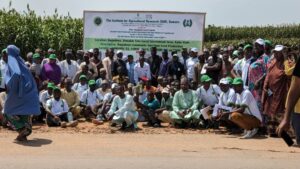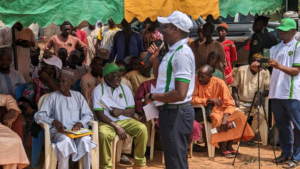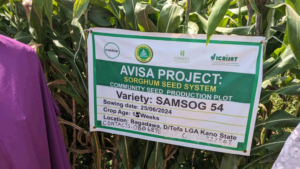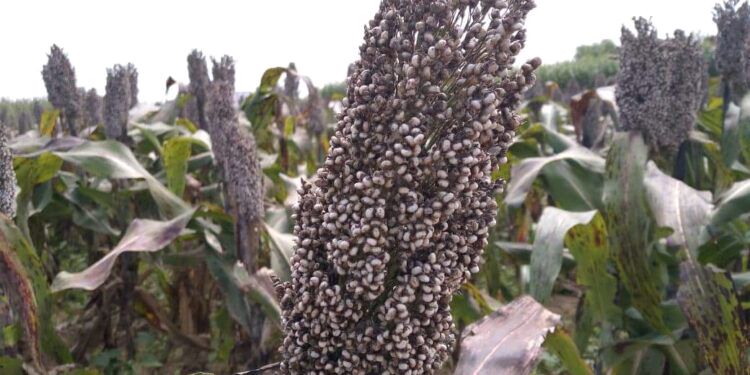Institute for Agricultural Research, IAR, Ahmadu Bello University, Samaru, Zaria has showcase its newly-released short-and medium-statured sorghum cultivars.
Eagleeyes reports that the showcasing of the cultivars, SAMSORG 52, SAMSORG 53, and SAMSORG 54 took place at a Field Day Demonstration, held at Bagadawa town in Dawakin Tofa Local Government Area of Kano in collaboration with the Dryland Crops, formerly known as the Accelerated Varietal Improvement and Seed Systems in Africa, (AVISA), project.

Speaking at the event, the Executive Director, IAR, Professor Ado Yusuf, said the newly-released sorghum varieties were developed through a painstaking research by the institute.
Represented by the Assistant Director Research, Professor Luscious.J Bamaiyi, the Director stated that sorghum is an important crop older than maize and other popular crops that needs to be developed for farmers to continue harness its potential for enhancing food security in the country.
He explained that the institute has bred four sorghum varieties which were showcased at the Field Day, aimed at producing crops that give farmers the opportunity of producing other crops within the stipulated rainy period.
Bamaiyi added that the short variety, The SAMSORG 52 was released in 2023 and has an outstanding characteristics of early maturing sorghum of 85-90 days and an average height of less than one meter, adding that “it has the potential yield of 3.5 tons per hectre.
“It is good for the Sudan/Sahelian region Where you have a very short rainy season,So within a period of two months, it gets ready for Harvest.
According to Bamaiyi, the SAMSORG 53 and SAMSORG 54, were released in 2023 with an outstanding characteristics of medium maturing of 95 – 100 days, adapted to Sudanian and North guinea Savannah with a high grain and biomass yield and are of medium maturing varieties.

While the yield of the two other varieties of 53 and 54 is about 3.7 and 3.8 tons per hectare, so they are very good varieties and they have good processing, qualities” he explained.
They are aimed at helping farmers to increase the yield.
And one interesting advantage of these varieties is that they can be grown in any period of the year and you can grow them under irrigation.
Now, you look at them, the powder, they have plenty of leaves. This means even after the harvest, the farmers would use the leaves for their livestock, so it has many advantages,” he said.
He assured farmers are their clients and the Institute would do everything possible to support them.
He conveyed the message of the Executive Director to thank the Kano Agricultural Research Development Agency for hosting the team from the Institute.
On his part, the Lead Agronomist, IAR, Prof. J.A.Y Shebanya, also explained that the seeds if planted well, will lead to bumper harvest.
Professor Shebanya noted that in some places when rainfall seizes, farmers complain about the growth of their crops, and that led to the researchers of the Institute to swing into action, which eventually led to the development of the sorghum varieties.
The Lead Agronomist maintained that the three varieties can be planted in both rainy and dry season.
In his remarks, the Country Director, International Crops Research Institute for the Semi-Arid Tropics, ICRISAT, Dr Angarawai Ignatius explained that the essence of developing the sorghum varieties is to meet up with the challenges faced by farmers as a result of climate change and insecurity in other parts of the country.
Dr Angarawai noted that due to the problems face by the farmers there is a need to develop seeds varieties that can be cultivated early with a combined harvester and that was why the varieties were released in order to prevent farms from being hideouts for criminals.
One of the reasons why we are here is to show farmers the sorghum varieties that have been newly released for commercial cultivation in Nigeria.
“We have by my left here, SAMSORG 52, which is short, not above the knee, especially for production in the insurgent areas, where they don’t allow tall crops to be grown and it takes us about 65 days from planting to maturity.
It has another one called 53, especially for the crop livestock is a system where you can harvest the grain and use the powder for animal produce.
While the 54, which is a glossy grain both for food and nutrition.

So this is the reason why AVISA, which is leading in sponsoring this seed production for the community has organized this program to showcase what they have been doing so far in terms of seed production in the community, so that the farmers in the rural community can have access other than waiting for seed from far away areas,” he said.
Eagleeyes report that the Field Day is a significant platform that highlights the advantages and benefits of the new sorghum
cultivars, including their adaptability, high yield potential, and suitability across various agro ecological zones.
The Field Day has helped in raising more awareness among rural farmers on the efficiency of the varieties and fostered market linkages, thereby strengthening the sorghum value chain.

